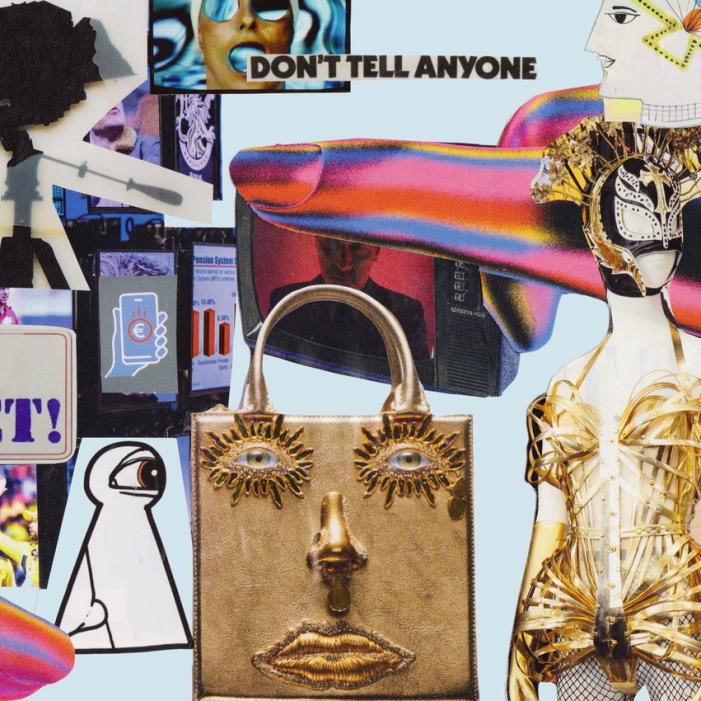What does surveillance have up its sleeve? Or now trending: tracking
In 2018, controversial Italian design duo Dolce & Gabbana sent a catwalk collection down the runway with the help of a fleet of miniature drones. A year later, Saudi Arabian stylist Ali Nabil Akbar presented a show in Jeddah which removed human models altogether and flew garments about a luxury hotel lobby with drones instead. Akbar felt that casting human models during Ramadan felt inappropriate and saw drone technology as a logical (and press-coverage-friendly) solution. Interestingly, the audience didn’t agree. They complained that the catwalk felt ghostly, even demonic, as disembodied dresses levitated through the air like ‘dementors’. In 2020, Vogue asked whether ‘fashion is ahead of facial recognition technology’ – the conclusion? Looking like ‘ourselves’ in public will come with an inevitable future cost.
Fashion and surveillance are inextricably linked. How we dress and present ourselves in public spaces affects how intelligent video management systems identify and predict our movements. Our self-presentation will influence the intervention of CCTV operators – likely with a heavy dose of bias. Finally, it will confirm or confuse biometric systems that try and establish identification. While this phenomenon used to only apply to places like borders or airports, we interact with these systems for increasingly mundane and day-to-day activities, such as logging into our online banking applications or asking Alexa to change up the music.
Some fashion has actually embraced surveillance technology, dressing it up as an empowering mechanism for optimizing our lives. Smartwatches use biometric data to track our fitness levels and claim to encourage healthier, more conscious lifestyles. RFID chips are increasingly used in the luxury fashion sector to authenticate items. They can also be used to prove their provenance and exclusivity as they move along the supply chain and outwards into secondary (retail) and tertiary (resale) economies. While convenient, these innovations also raise questions about the extent to which individuals will willingly trade their personal data for convenience, status and style.
The integration of cameras into wearable devices is another example of fashion’s reflection of surveillance. Devices like the ill-fated Google Glasses and micro-camera-equipped accessories emphasize the desire to record and share every aspect of life, blurring the lines between capturing meaningful memories, safety and personal privacy. When the fashion sector absorbs wider cultural phenomena, they can safely be assumed to have been entirely integrated into the commercial mainstream. It tends to represent a sort of ‘point of no return’; as soon as something becomes fashionable, it is presented back to us as both marketable and desirable. So, while fashion has offered opportunities for political resistance in the past, the contemporary ubiquity and confusion of consumer culture seriously restricts what can be considered ‘anti-establishment.’ After all, it’s so much more pleasurable and straightforward to just ‘add to cart.’
Anti-surveillance fashion uses geometric and disjointed patterns and textile designs that confuse identification algorithms, challenging infrastructural ability to track individuals without their consent. However, the unfortunate trade-off between style and surveillance is that to effectively bypass the monitoring techniques that have become widespread in the Global North, we must disrupt and fragment ourselves to the point of abstraction. Anti-surveillance clothing can thwart some tracking mechanisms, but these busy, jagged prints must be extended to facial makeup if they are going to sidestep facial recognition software, too. Writing for Vogue, Nathan Heller calls this ‘protective decoration’ and explains that clean, pared-down makeup could become a visual shortcut for collaborating with facial recognition technologies. Suddenly, a bare face borders on a political statement. It’s as though the normalization of surveillance has left us in a dystopian Scooby-Doo-esque scenario of masquerade, imitation and deflection. When costuming becomes a survival mechanism, it certainly ceases feeling playful and enjoyable.
And let us not forget that fashion has promoted new forms of self-surveillance more than almost any other sector. Influencer culture and the omnipresence of social media have blurred the public and private spheres. It has encouraged self-imposed practices of screening, recording, and the almost enthusiastic surrender of data to corporations. Not only do we curate our appearance for the scrutiny of virtual audiences, soothing our need for validation and visibility at once, but the data we generate will become a sort of algorithmic North Star. That data is used, in all too tangible ways, to influence our future thinking and purchasing behaviour. We are actively consenting to the creation of a roadmap for our own manipulation through this voluntary surrender of privacy.
In all, the relationship between fashion and surveillance is fraught with tension. While some innovative designers and products offer tools for evading surveillance, the proliferation of self-surveillance appears to be a much more powerful cultural force. Whether it is the validation offered up by the fashioned social-digital self or the clarity and conveniences of smart tracking devices, questions of privacy take a backseat where the attention economy is concerned. Visibility is currency, and recognition is a much more tempting fate than being forgotten. We must remember to constantly ask ourselves what sort of compromises we are willing to make as surveillance capitalism becomes the norm. We must be aware that the spectre of surveillance may be getting quite skilled at dressing itself up as other things.
Text: Louisa Rogers
Sign Up To Little Crack


